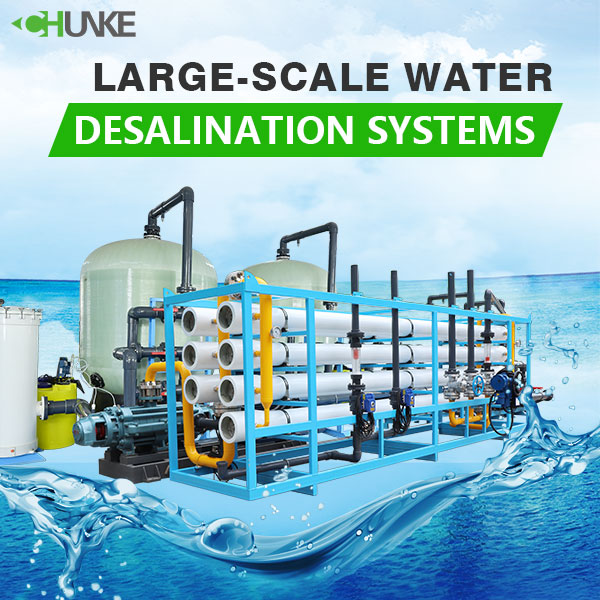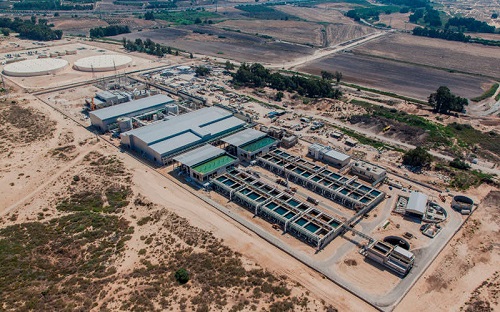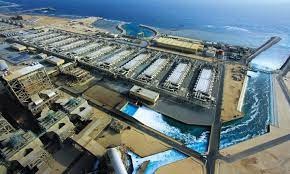Large Scale Water Desalination Systems: A Solution for Water Scarcity
Chunke provides large-scale water desalination systems with high technology. Water scarcity is a pressing issue in many parts of the world, especially in arid regions where freshwater sources are limited. To address this challenge, large-scale water desalination systems have emerged as a viable solution. These systems utilize advanced technologies to convert seawater or brackish water into clean, potable water. In this article, we will explore the different types of large-scale water desalination systems, their benefits, and their impact on water sustainability.

Introduction to Large Scale Water Desalination Systems
Water desalination is the process of removing salt and impurities from seawater or brackish water to produce freshwater. Large-scale water desalination systems are designed to meet the growing demand for clean water in regions with limited freshwater resources. These systems employ various technologies, such as reverse osmosis (RO) and multi-stage flash distillation (MSF), to achieve efficient and cost-effective water purification.
Reverse Osmosis (RO) Systems
Reverse osmosis (RO) is one of the most widely used technologies in large-scale water desalination systems. It works by applying pressure to seawater or brackish water, forcing it through a semi-permeable membrane that allows water molecules to pass through while blocking salt and other impurities. The purified water is collected, while the concentrated saltwater, known as brine, is discharged.
Multi-Stage Flash Distillation (MSF) Systems
Multi-stage flash distillation (MSF) is another commonly employed technology in large-scale water desalination. It involves heating seawater in multiple stages to produce steam, which is then condensed to produce freshwater. This process utilizes the principle of evaporation and condensation to separate water from salt and impurities.
Advantages of Large Scale Water Desalination Systems
Large-scale water desalination systems offer several benefits in addressing water scarcity and ensuring a sustainable water supply. These advantages include:
Reliable Source of Clean Water
Large-scale water desalination systems provide a reliable source of clean, potable water, regardless of the availability of freshwater sources. This is especially crucial in arid regions where traditional water sources are limited or contaminated.
Independence from Rainfall Patterns
Unlike traditional water sources, which rely on rainfall patterns, large-scale water desalination systems are not dependent on weather conditions. They can operate consistently, ensuring a stable water supply even during droughts or dry seasons.
Mitigation of Water Stress
By tapping into seawater or brackish water sources, large-scale water desalination systems alleviate the pressure on freshwater sources, reducing water stress in regions facing water scarcity issues. This helps preserve existing freshwater resources for other essential purposes.
Reduction of Environmental Impact
Large-scale water desalination systems, particularly those utilizing reverse osmosis technology, have a lower environmental impact compared to other water purification methods. They consume less energy and produce less brine, minimizing their carbon footprint and potential harm to marine ecosystems.
Notable Large-Scale Water Desalination Projects
Several large-scale water desalination projects have gained prominence for their size, efficiency, and contribution to water sustainability. Let's explore some of these noteworthy projects:
A. Ras Al Khair, Saudi Arabia: 1,036,000 m3/day

The Ras Al Khair desalination plant in Saudi Arabia is one of the largest and most significant projects in the world. With a capacity of 1,036,000 cubic meters per day, it utilizes a hybrid system combining thermal multistage flash (MSF) and reverse osmosis (RO) technologies. The plant serves Riyadh and other cities, providing a substantial amount of clean water to meet the region's growing demand.
B. Sorek, Israel: 150 million cu meters per year

The Sorek desalination plant in Israel is another notable example of large-scale water desalination. With a capacity of 150 million cubic meters per year, it uses reverse osmosis technology to convert seawater into potable water. The plant, jointly operated by IDE Technologies and Hutchison Water International Holdings, has significantly contributed to Israel's water sustainability, providing clean water to over 1.5 million people.
C. Al Jubail, Saudi Arabia: 1.4 million cubic meters per day

The Al Jubail desalination plant in Saudi Arabia is the world's largest desalination plant in terms of daily water production. With a capacity of 1.4 million cubic meters per day, it utilizes advanced technologies, including reverse osmosis, to desalinate seawater and provide clean water to the region. The plant plays a crucial role in meeting the water needs of both industrial and residential sectors in the area.
Innovations in Large Scale Water Desalination Systems
Continuous research and development efforts have led to significant innovations in large-scale water desalination systems. Researchers and engineers are constantly working towards improving efficiency, reducing energy consumption, and minimizing environmental impact. Here are some notable innovations in the field:
Filter-Free Technology
One significant innovation in large-scale water desalination systems is the adoption of filter-free technology. Traditional systems require high-pressure pumps and filtration units, which are challenging to miniaturize without compromising energy efficiency. However, new advancements, such as ion concentration polarization (ICP), eliminate the need for filters. ICP applies an electrical field to membranes, repelling charged particles and allowing clean water to pass through.
Energy-Efficient Processes
Energy consumption is a critical factor in large-scale water desalination systems. Innovations in energy-efficient processes, such as improved membrane materials, optimized pressure centers, and advanced energy recovery systems, have significantly reduced energy requirements. This not only lowers operational costs but also contributes to the overall sustainability of large-scale desalination projects.
Resource Recovery
To further enhance the sustainability of large-scale water desalination systems, researchers are exploring ways to recover valuable resources from the desalination process. For example, minerals like sodium chloride salt, magnesium, and calcium can be extracted from seawater, providing additional economic benefits. This approach reduces waste and maximizes the utilization of seawater resources.
Future Prospects and Challenges
Large-scale water desalination systems hold immense potential in addressing water scarcity and ensuring a sustainable water supply. However, several challenges need to be addressed for wider adoption and improved efficiency.
Cost-Effectiveness
While large-scale water desalination systems have become more cost-effective over the years, they still require significant investments in infrastructure, technology, and maintenance. Continued research and development are essential to drive down costs and make these systems more accessible to regions with limited financial resources.
Environmental Impact
Although large-scale water desalination systems have a lower environmental impact compared to other water purification methods, there is still room for improvement. Efforts should focus on minimizing brine discharge, mitigating the impact on marine ecosystems, and exploring sustainable brine management solutions.
Technological Advancements
Advancements in technology, such as improved membrane materials, energy recovery systems, and innovative desalination processes, will play a crucial role in enhancing the efficiency and effectiveness of large-scale water desalination systems. Continued research and innovation are necessary to overcome existing limitations and unlock the full potential of these systems.
Conclusion
Large-scale water desalination systems have revolutionized the way we address water scarcity, providing a reliable source of clean water in regions with limited freshwater resources. Through advancements in technology and ongoing research, these systems have become more efficient, cost-effective, and sustainable. As we continue to face water scarcity challenges, large-scale water desalination systems offer hope for a brighter and more water-secure future. By harnessing the power of innovation, we can ensure a sustainable water supply for generations to come.
—— by Louisa@gzchunke.com




